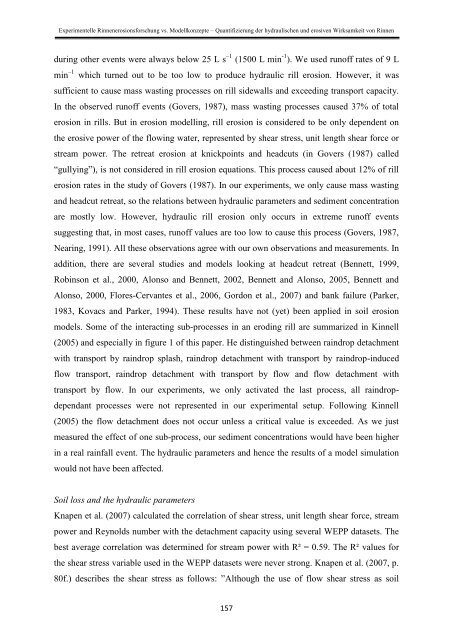Stefan Wirtz Vom Fachbereich VI (Geographie/Geowissenschaften ...
Stefan Wirtz Vom Fachbereich VI (Geographie/Geowissenschaften ...
Stefan Wirtz Vom Fachbereich VI (Geographie/Geowissenschaften ...
Create successful ePaper yourself
Turn your PDF publications into a flip-book with our unique Google optimized e-Paper software.
Experimentelle Rinnenerosionsforschung vs. Modellkonzepte – Quantifizierung der hydraulischen und erosiven Wirksamkeit von Rinnen<br />
during other events were always below 25 L s –1 (1500 L min -1 ). We used runoff rates of 9 L<br />
min –1 which turned out to be too low to produce hydraulic rill erosion. However, it was<br />
sufficient to cause mass wasting processes on rill sidewalls and exceeding transport capacity.<br />
In the observed runoff events (Govers, 1987), mass wasting processes caused 37% of total<br />
erosion in rills. But in erosion modelling, rill erosion is considered to be only dependent on<br />
the erosive power of the flowing water, represented by shear stress, unit length shear force or<br />
stream power. The retreat erosion at knickpoints and headcuts (in Govers (1987) called<br />
“gullying”), is not considered in rill erosion equations. This process caused about 12% of rill<br />
erosion rates in the study of Govers (1987). In our experiments, we only cause mass wasting<br />
and headcut retreat, so the relations between hydraulic parameters and sediment concentration<br />
are mostly low. However, hydraulic rill erosion only occurs in extreme runoff events<br />
suggesting that, in most cases, runoff values are too low to cause this process (Govers, 1987,<br />
Nearing, 1991). All these observations agree with our own observations and measurements. In<br />
addition, there are several studies and models looking at headcut retreat (Bennett, 1999,<br />
Robinson et al., 2000, Alonso and Bennett, 2002, Bennett and Alonso, 2005, Bennett and<br />
Alonso, 2000, Flores-Cervantes et al., 2006, Gordon et al., 2007) and bank failure (Parker,<br />
1983, Kovacs and Parker, 1994). These results have not (yet) been applied in soil erosion<br />
models. Some of the interacting sub-processes in an eroding rill are summarized in Kinnell<br />
(2005) and especially in figure 1 of this paper. He distinguished between raindrop detachment<br />
with transport by raindrop splash, raindrop detachment with transport by raindrop-induced<br />
flow transport, raindrop detachment with transport by flow and flow detachment with<br />
transport by flow. In our experiments, we only activated the last process, all raindropdependant<br />
processes were not represented in our experimental setup. Following Kinnell<br />
(2005) the flow detachment does not occur unless a critical value is exceeded. As we just<br />
measured the effect of one sub-process, our sediment concentrations would have been higher<br />
in a real rainfall event. The hydraulic parameters and hence the results of a model simulation<br />
would not have been affected.<br />
Soil loss and the hydraulic parameters<br />
Knapen et al. (2007) calculated the correlation of shear stress, unit length shear force, stream<br />
power and Reynolds number with the detachment capacity using several WEPP datasets. The<br />
best average correlation was determined for stream power with R² = 0.59. The R² values for<br />
the shear stress variable used in the WEPP datasets were never strong. Knapen et al. (2007, p.<br />
80f.) describes the shear stress as follows: ”Although the use of flow shear stress as soil<br />
157
















